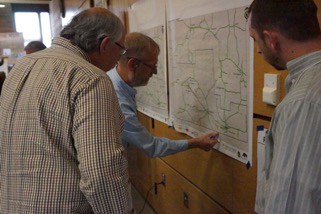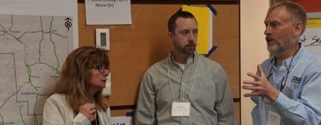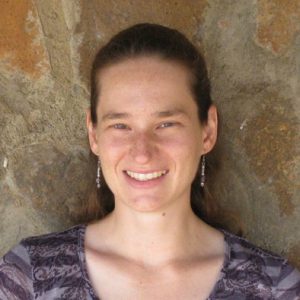Interagency Spotlight: Wyoming Wildlife and Roadways Summit Brings Many Together
By Corinna Riginos, Board Member-at-large

Summit attendees discussing areas of concern, options for reducing negative effects of vehicles on wildlife, and improving habitat connectivity. Photo courtesy of WYDOT.
Just as the epic winter of 2016-2017 was dropping yet another (and not quite the last) snowstorm, a group of 140 representing the Wyoming Department of Transportation (WYDOT), Wyoming Game and Fish Department (WGFD), numerous wildlife and conservation NGOs, scientists, legislators, and citizens gathered in Pinedale in late April for the first ever Wyoming Wildlife and Roadways Summit. The Summit was organized and led by Daryl Lutz (WGFD) and Kenneth Keel (WYDOT) and several other partners, with the intention of strengthening relationships and enhancing communications among WGFD, WYDOT, NGOs, and others, with the ultimate goal of promoting action to reduce the negative effects of roads on wildlife. The Wyoming Chapter of The Wildlife Society was one of several key sponsors that supported the Summit and made it possible for a diverse audience to attend.
Over this two-day Summit, participants attended a series of talks and breakout groups to share their ideas and expertise. Speakers emphasized what we know about the impacts of roads on Wyoming’s ungulate wildlife, the problem of wildlife-vehicle collisions in terms of public safety, the history of work that has been done to address these issues, the importance of conserving ungulate movement and migration corridors, strategies for mitigating negative interactions between vehicles and wildlife, and strategies for effective funding partnerships.

Attendees discussing the issues surrounding wildlife and vehicle collisions. Photo courtesy of WYDOT.
No doubt many participants were thinking of the large number of animals killed on Wyoming’s roads over the long winter that had not yet entirely passed. The winter’s deep snows constrained the habitat accessible to many ungulates, which left them even more vulnerable than usual to being hit by vehicles. And as the Summit’s speakers emphasized, roads present a major habitat connectivity barrier for wildlife, in addition to being a significant source of animal mortality. Several talks highlighted the successes of road under- and over-passes that WYDOT installed at Trapper’s Point, Nugget Canyon, and Baggs over the last decade; these crossing structures have reduced ungulate-vehicle collisions by ~80% in these areas and increased habitat connectivity for multiple mammal species. Others laid out the challenges that animals still face in many locations around Wyoming.
Since one of the goals of the Summit was to promote action, two breakout group activities formed key parts of the event. The first group activity was to brainstorm opportunities for collaboration and partnership to address the problem. One of the most exciting parts of the Summit was seeing the level of energy and enthusiasm for partnerships among agencies, NGOs, legislators, and others to raise funds and implement actions. On day two, breakout groups again got to work, this time identifying and prioritizing locations for possible future mitigations. Groups huddled around large maps of wildlife collision data, circling and marking up the maps to indicate places where they felt actions are most urgently needed. Priority actions ranged from improving driver awareness and education around the hazards of wildlife in highway right-of-ways, to modifying fences along right-of-ways, to installing wildlife crossing structures where roads are significantly impairing wildlife habitat connectivity.
Participants left the Summit energized, but fully aware that much more work needs to be done before their good ideas and intentions can turn into action. Summit organizers are already working to plan next steps, so stay tuned! Given the high level of interest and commitment, including from leadership at WGFD and WYDOT, we are optimistic that this initiative will lead to tangible actions to reduce the negative effects of roads on wildlife in Wyoming.
 Corinna Riginos is a Research Associate with the Northern Rockies Conservation Cooperative and an Adjunct Professor at the University of Wyoming. She has spent most of her career working on wildlife-habitat relationships in human-dominated landscapes.
Corinna Riginos is a Research Associate with the Northern Rockies Conservation Cooperative and an Adjunct Professor at the University of Wyoming. She has spent most of her career working on wildlife-habitat relationships in human-dominated landscapes.


